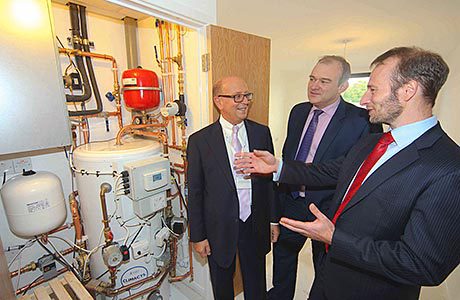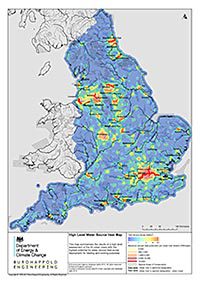The UK has been somewhat slow to exploit renewable heat from rivers and waterways, says one academic, as DECC unveils a national map highlighting opportunities for it.

In late August the Department of Energy & Climate Change (DECC) published a national water source heat map, highlighting opportunities in the UK for open water heat pump installations.
The map summarises the result of a high level assessment of around 40 urban rivers with the highest potential for water source heat pump deployment, for both heating and cooling purposes; the map does this by identifying areas of high heat demand, adjacent to rivers with sufficiently high flow rates. The map also provides a high level indication of locations sensitive to environmental factors, which may provide a further constraint to development.
This map has been developed for local authorities, community groups and private developers in order to highlight the opportunities for deploying this innovative technology at larger scales (i.e. for heat networks).
The aim of the map is to raise awareness of this untapped potential and to encourage stakeholders to consider water source heat pumps as an option when planning for local, sustainable energy solutions. According to DECC: “We are aiming to deliver a more detailed water source heat map in the winter. This will form an important part of the new National Heat Map, which is currently being developed further”.
The Department was tasked with the preparation of the map by Ed Davey, the Secretary of State for Energy and Climate Change, when he formally switched on the award-winning Kingston Heights Open Water Heat Pump community heating system in October last year.
This £70 million, mixed-use development in Surrey harvests renewable, low grade heat from the Thames and transfers it 200 metres from the river to the development’s 137 apartments and 142-bed hotel and conference centre.
An important role in the project was played by Mitsubishi Electric and its advanced heat pump technology which boosts the low grade heat provided by solar energy naturally stored in the river (and every open body of water) to the temperature required to provide all the heating and hot water for the flats and the hotel (as well as providing the cooling requirement for the individual hotel rooms).
In September an engineering academic in Scotland warned that the UK’s use of river source heat pump technology was falling behind.
Professor Paul Younger, Rankine Chair of Engineering at Glasgow University, encouraged Scotland not to ignore the potential of watercourses and deep mine workings as a source of warmth.

Catching up with Scandinavia
Speaking before a Scottish Renewables event held at Glasgow University, Prof Younger said: “As is so often the case, the Norwegians saw the light earlier than us, and heat-pump technology built on the Clyde is now heating the city of Drammen by extracting thermal energy from deep fjord waters.
“Meanwhile the Clyde, Forth, Moray, Tay, Solway – our own ‘fjords’, and the source of the word ‘firth’ – flow by, delivering their renewable thermal content to the open ocean unused while heat poverty is such a problem for so many.”
Water from underground mine workings can also be used to feed heat pumps. Younger’s own research has found that of less than 20 examples of this worldwide, two are in Scotland – one heating homes in Shettleston, Glasgow, and another in Lumphinnans, Fife.
Modern heat pumps use small amounts of electricity to turn cool water from rivers and lakes into hot water. Technology developed in Scotland is already being used to heat 2˚C water from a fjord in Norway to 90˚C.
See https://www.gov.uk/government/publications/water-source-heat-map for DECC’s map.







